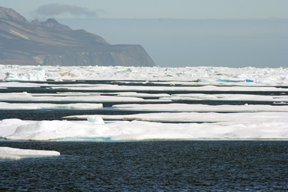|
News Notes
Oceanography
Conveyor belt shutdown not imminent
 As Earth warms, the ice on Greenland is melting. What will happen next, however, as freshwater pours from the ice sheet into the North Atlantic, remains a mystery. Climate modelers have been working for years to figure out what will happen, especially to ocean circulation patterns that work to keep Europe and northern latitudes hospitable. Now, new model results are suggesting that changes may not be as drastic as once thought.
As Earth warms, the ice on Greenland is melting. What will happen next, however, as freshwater pours from the ice sheet into the North Atlantic, remains a mystery. Climate modelers have been working for years to figure out what will happen, especially to ocean circulation patterns that work to keep Europe and northern latitudes hospitable. Now, new model results are suggesting that changes may not be as drastic as once thought.
As the climate warms and ice on Greenland melts, freshwater pours into the North Atlantic, which new research suggests is unlikely to cause a shutdown in global ocean circulation. Photograph is by Richard Alley.
The ocean “conveyor belt,” which shuttles warm, salty water northward along the North American coast and around Europe, is affected by inputs of freshwater, such as from the melting Arctic. A critical part of the conveyor belt is around Greenland, where colder, saltier waters dive beneath the warmer waters. If a large amount of freshwater is suddenly deposited into the circulation around this area, it can then throw the whole system into chaos — potentially causing a weakening of the circulation or even a shutdown, which could bring cooler temperatures to Europe and other parts of the world.
Paleoclimatic evidence suggests that the conveyor belt, called the thermohaline circulation (THC), has actually halted in the past due to a sudden influx of freshwater and triggered abrupt climate change, says Tim Osborn, a climatologist with the Climatic Research Unit at the University of East Anglia in the United Kingdom. The worry is that with current and projected warming temperatures over the next few centuries, significant melting of the Greenland Ice Sheet could pour too much freshwater into the North Atlantic and cause the THC to shut down again.
Such a shutdown and abrupt climate change, however, is “not a realistic scenario” for the next two centuries, wrote Johann Jungclaus at the Max Planck Institute for Meteorology in Hamburg, Germany, and colleagues in the Sept. 7 Geophysical Research Letters. That conclusion is based on results from a series of simulations using a range of temperatures over the next two centuries, as projected by the Intergovernmental Panel on Climate Change, Jungclaus says.
The most conservative global temperature estimate, an increase of 0.5 degrees Celsius, and the maximum estimate, 4.0 degrees Celsius warming by the end of this century, yielded a range of meltwater inputs, with a range of reduction in circulation. The reduction varied between 35 and 42 percent over the next century, compared to a 30 percent reduction in a model simulation that did not even take into account Greenland meltwater input.
Jungclaus says, however, that even in the most extreme case of meltwater input, the models showed that the circulation would recover in the 22nd century. No models showed an abrupt collapse of the conveyor belt, he says.
“Their conclusions certainly seem valid and not dissimilar to previous assessments” that the Atlantic THC will gradually weaken over the 21st century due to warming, Osborn says. “Nevertheless, until we have shown that our climate models can fully and accurately simulate such behavior as this that occurred in the past, there is still that relatively small chance that the real-world THC might react more abruptly to 21st century climate change than our current climate models suggest,” he says.
Richard Alley, a paleoclimatologist at Pennsylvania State University in University Park, says that this study is important in that it is one of the first to include freshwater input from the melting of the Greenland Ice Sheet. Most models only have considered precipitation and salt reduction from sea-ice melt, and in some cases, temperature changes, he says. Those models have shown similar results, though, “so the basic picture of a slowdown in a warming future is broadly consistent with most model runs,” Alley says.
A bigger question, however, is whether the Greenland melt tells the whole story, Alley says. Climatologists are increasingly realizing that the abrupt climate change events of the past, such as during the Younger Dryas cool period about 12,000 years ago, “were primarily mediated through seasonal sea ice,” he says, not ice sheets. Sea ice may be more capable of changing temperature than anything else in the climate system, he says, so that may be a bigger factor than Greenland melt and freshwater influx. It’s an open question, he says.
Megan Sever

 Subscribe
Subscribe

